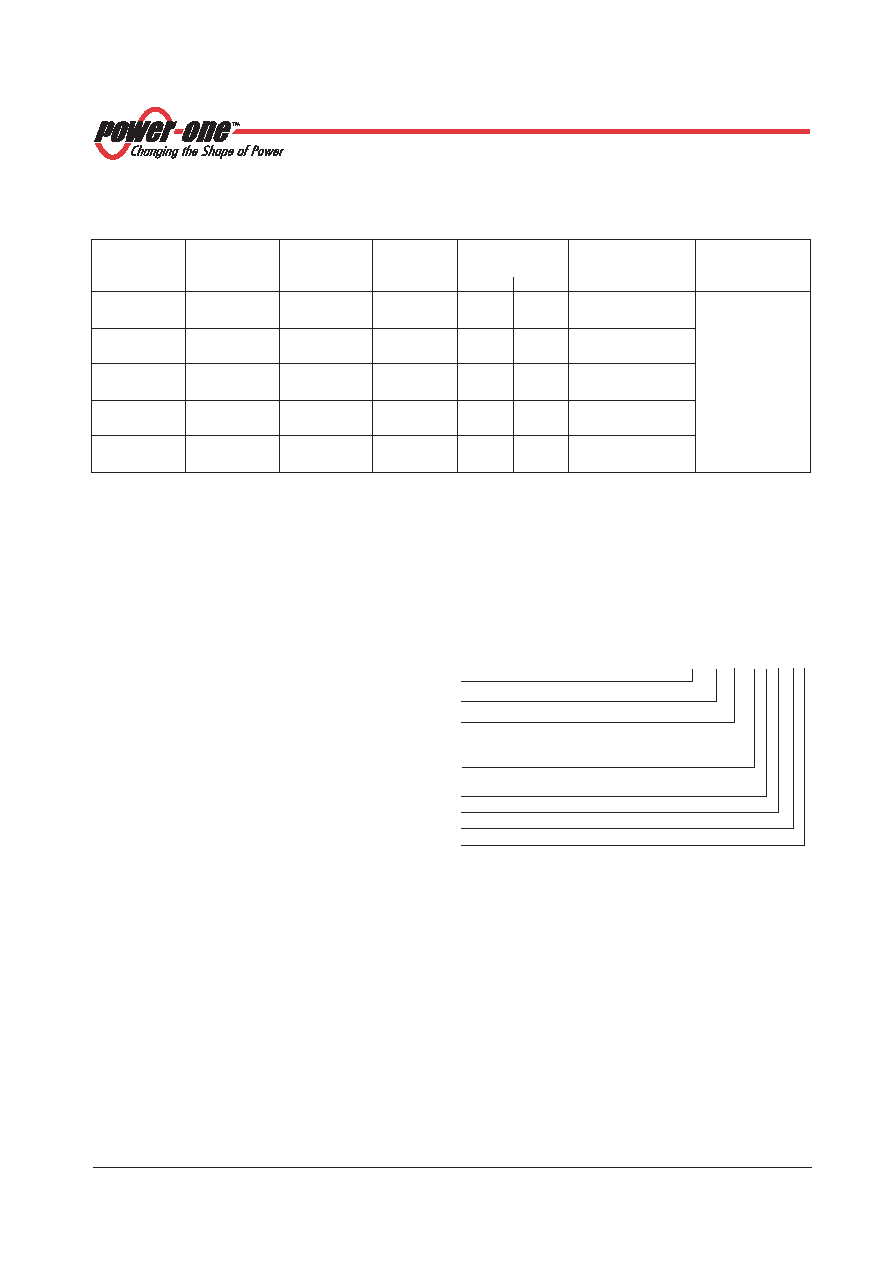- 您現(xiàn)在的位置:買賣IC網(wǎng) > PDF目錄69139 > PSK4812-9CB1 (POWER-ONE INC) 1-OUTPUT DC-DC REG PWR SUPPLY MODULE PDF資料下載
參數(shù)資料
| 型號: | PSK4812-9CB1 |
| 廠商: | POWER-ONE INC |
| 元件分類: | 電源模塊 |
| 英文描述: | 1-OUTPUT DC-DC REG PWR SUPPLY MODULE |
| 封裝: | METAL, CASE K01, MODULE |
| 文件頁數(shù): | 11/18頁 |
| 文件大小: | 366K |
| 代理商: | PSK4812-9CB1 |

PSS, PSK Extended Data Sheet
Positive Switching Regulator (Rugged)
REV. FEB. 25 2004
Page 2 of 18
Model Selection and Key Data
Table 1: Type survey
Output
Input
Efficiency 2
Type
Options
voltage
current
voltage range
voltage
designation
Vo nom [V]
Io nom [A]
Vi [V] 1
Vi nom [V]
h
hmin [%] h
h
htyp [%]
12
9
18 - 144
60
90
91
PSS 129-7
B, B1
12
18 - 144
60
90
91
PSK 1212-7
-9
15 3
9
22 - 144
60
90
92
PSS 129-7
E
15 3
12
22 - 144
60
90
92
PSK 1212-7
P
24
9
31 - 144
60
93
94
PSS 249-7
C
24
12
31 - 144
60
93
94
PSK 2412-7
36
9
44 - 144
80
95
96
PSS 369-7
36
12
44 - 144
80
95
96
PSK 3612-7
48
9
58 - 144
80
96
97
PSS 489-7
48
12
58 - 144
80
96
97
PSK 4812-7
1 Surges up to 156 V for 2 s. See also: Electrical Input Data: DVio min.
2 Efficiency at Vi nom and Io nom.
3 Output set to 15 V at R control input
Part Number Description and Product Marking
Type Key
PSK 12 12 -7 E P C B
Positive switching regulator in case S01, K01 .. PSS, PSK
Nominal output voltage in volt .............................. 12, ...48
Nominal output current in ampere ............................ 9, 12
Operational ambient temperature range
T
A
–25 to 71°C ................................................ -7
–40 to 71°C (option) .................................. -9
Options:
Inrush current limitation ............................... E
Potentiometer 1 ............................................ P
Thyristor crowbar ........................................ C
Cooling plate large/small ..................... B, B1
1 Option P excludes R-features and vice versa.
Example:
PSS 129-7EPCB = A positive switching regulator with a 12 V, 9 A output, ambient temperature range of
–25 to 71°C, inrush current limitation, potentiometer, crowbar and large cooling plate B.
Non standard input/output configurations or special custom adaptions are available on request.
Note: All units feature the following auxiliary functions
which are not shown in the type designation: Input filter, in-
hibit, R control, sense lines, current sharing and test jacks.
Produkt Marking
Basic type designation, applicable safety approvals and
recognition marks, warnings, pin allocation, Power-One
patents and
company logo, identification of LED, test
sockets and optional potentiometer.
Specific type designation, input voltage range, nominal
output voltage and current, protection degree, batch no.,
serial no. and data code including production site,
modification status and date of production.
相關(guān)PDF資料 |
PDF描述 |
|---|---|
| PSS489-9EP | 1-OUTPUT DC-DC REG PWR SUPPLY MODULE |
| PSS369-9EPC | 1-OUTPUT DC-DC REG PWR SUPPLY MODULE |
| PSS369-9EPCB1 | 1-OUTPUT DC-DC REG PWR SUPPLY MODULE |
| PSK2412-7ECB1 | 1-OUTPUT DC-DC REG PWR SUPPLY MODULE |
| PSS369-9ECB1 | 1-OUTPUT DC-DC REG PWR SUPPLY MODULE |
相關(guān)代理商/技術(shù)參數(shù) |
參數(shù)描述 |
|---|---|
| PSK4812-9ECB | 制造商:Power-One 功能描述:DCDC - Bulk |
| PSK485I | 制造商:Panduit Corp 功能描述:STRUT CLAMP FOR 3 CONDUIT 制造商:Panduit Corp 功能描述:UNIVERSAL STRUT CLAMP FOR 3 EMT/RIGID/I 制造商:Panduit Corp 功能描述:UNIVERSAL STRUT CLAMP FOR 3 CONDUIT |
| PSK565I | 制造商:Panduit Corp 功能描述:UNIVERSAL STRUT CLAMP FOR 3 1/3 EMT/RIG 制造商:Panduit Corp 功能描述:UNIVERSAL STRUT CLAMP FOR 3-1/2 CONDUIT |
| PSK5A16-7 | 功能描述:SWITCHING REGULATOR 81.6W 5.1V RoHS:是 類別:電源 - 板載 >> DC DC Converters 系列:* 標(biāo)準(zhǔn)包裝:5 系列:* |
| PSK5A16-9 | 制造商:Power-One 功能描述:DC/DC PS SGL-OUT 5.1V 16A 81.6W 15PIN - Bulk |
發(fā)布緊急采購,3分鐘左右您將得到回復(fù)。